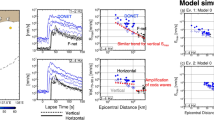Abstract
Wide angle acquisition has been taken as a significant measure to obtain high quality seismic data and is getting greater attention. In this paper, we discuss ocean bottom cable (OBC) seismic wide angle reflections on the basis of a layered model experiment. Some experiment results don’t support theoretical conclusions. The main experimental conclusions are: 1. Wide angle reflection energies are stronger than non-wide-angle reflections (up to twice as strong) but there is a big difference between observations and theoretical calculations that suggest the wide angle reflection energies are 15 times the nonwide-angle reflection energy. The reflection energy increases gradually rather than sharply as the theoretical calculations suggest. 2. The reflection events remain hyperbolic when the offset increases. 3. Wide angle reflection dominant frequency is about 20–30% less than nonwide-angle reflections and decreases as the offset increases. The non-wide-angle reflection dominant frequency shows no obvious variation for small offsets. 4. There is no wave shape mutation or polarity reversal near the critical angle. 5. The reflection event group features are the same for both cases of incidence angle greater and less than the critical angle. 6. Direct arrivals, multiples, and water bottom refractions influence the wide angle reflections of the sea floor.
Similar content being viewed by others
References
Brittan, J., and Warner, M., 1997, Wide-angle seismic velocities in heterogeneous crust: Geophysics, 129, 269–280.
Clowes, R. M., White, D. J., Hajnal, Z., 2010, Mantle heterogeneities and their significance; results from Lithoprobe seismic reflection and refraction; wide-angle reflection studies: Canadian Journal of Earth Sciences, 47(4), 409–443.
Dixit, M. M., Tewari, H. C., Rao, C., and Visweswara, 2010, Two-dimensional velocity model of the crust beneath the south Cambay Basin, India from refraction and wide-angle reflection data: Geophysical Journal International, 181(2), 635–652.
Feng, D. Y., 1984, Theory of seismic waves and application: Petroleum Industry Publishing House (in Chinese), Beijing.
Fliedner, M., and White, R., 1999, Using wide angle seismic data for basalt and sub-basalt imaging: 69th Ann. Internat. Mtg., Soc. Explor. Geophys., Expanded Abstracts, 186–191.
Hu, Z. P., Guan, L. P., Gu, L. X., Wang, L. S., Wu, D. L., Dong, Y. R., and Zhao, Q., 2004, Wide angle seismic wave field analysis and imaging method below the high velocity shield layers: Chinese Journal of Geophysics (in Chinese), 47(1), 88–94.
Klingelhoefer, F., Lee, C. S., Lin, J. Y., and Sibuet, J. C., 2009, Structure of southernmost Okinawa Trough from reflection and wide-angle seismic data: Tectonophysics, 466(3), 281–288.
Liu, J. H., 2000, OBS wide angle seismic reflection and its significance: DongHai Marine Science (in Chinese), 18(1), 15–20.
Oueity, J., and Clowes, R. M., 2010, Nature of the Moho transition in NW Canada from combined near-vertical and wide-angle seismic-reflection studies: Lithosphere, 2(5), 377–396.
Sun, C. Y., Ni, C. K., Li, S. J., and Zhang, Y. H., 2007, Feature of wide-angle reflection data and correction method: Oil Geophysical Prospecting (in Chinese), 42(1), 24–29.
Wang, Z., He, Z. H., Huang, D. J., Wang, X. M., and Du, Z. C., 2003, The wave-field features researching of wide angle reflection and the analyzing of forward modeling: Progress in Geophysics (in Chinese), 18(1), 116–121.
Zhang, W. P., Guo, P., and Hu, T. Y., 2004, Study and practice of wide-angle seismic data processing: Applied Geophysics, 1(1), 31–37.
Zhao, H. R., Tang, W. B., and Guo, T. S., 1984, Ultra-acoustic seismic model test techniques and applications: Petroleum Industry Publishing House (in Chinese), Beijing.
Zhao, H. R., Sun, J. Z., Tang, W. B., and Peng, Y. M., 1991, Full waveform seismic phase analysis: Seismological Publishing House (in Chinese), Beijing.
Zhu, G. G., Wu, L., Xu, Y., 1996, Reservoir geophysical parameters extraction): Seismological Publishing House (in Chinese), Xi’an.
Author information
Authors and Affiliations
Additional information
Yang Zheng-Hua is a professor at the Geophysics Department of Changan University. He received his PhD in Applied Geophysics from Changan University. His research interests are geology, modeling experiments, VSP, and surface multi-component seismic exploration
Rights and permissions
About this article
Cite this article
Yang, ZH., Huang, YJ. & Wu, YX. Wide angle reflections in OBC seismic physical model experiment. Appl. Geophys. 9, 207–212 (2012). https://doi.org/10.1007/s11770-012-0331-7
Received:
Revised:
Published:
Issue Date:
DOI: https://doi.org/10.1007/s11770-012-0331-7



